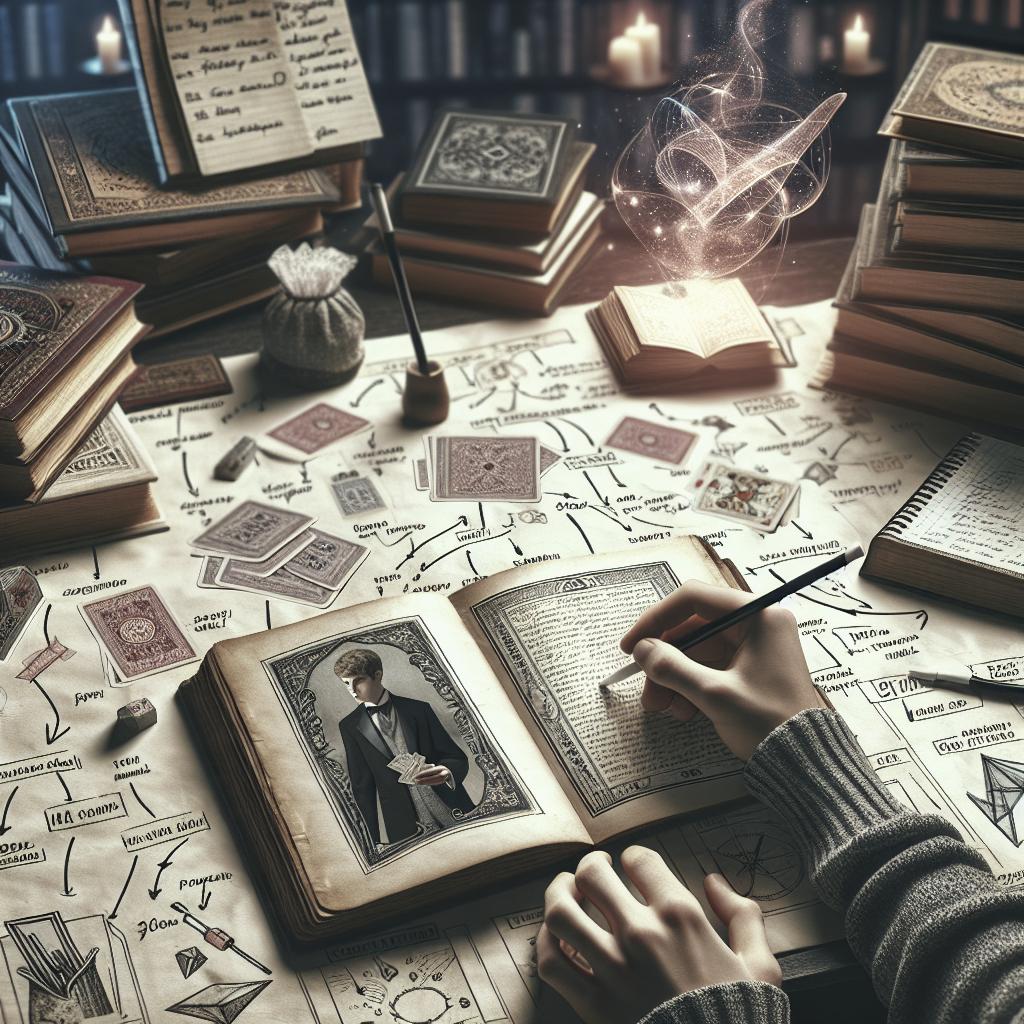“`html
The World of Illusions: Unveiling a Magician’s Secrets
In the enchanting world of magic, illusions have captivated audiences for centuries. Magicians possess a unique ability to defy logic and leave spectators in awe. In this blog post, we delve into the captivating realm of magic to explore how magicians create their most mystifying illusions. From making objects vanish into thin air to levitating them before our eyes, and even changing colors at the flick of a wrist, we uncover the techniques and artistry behind these magical feats. Read on to find out how they craft these illusions, stirring the imagination and challenging our perception of reality.
Commonly Asked Questions
How do magicians make things appear out of nowhere? 🪄
Magicians have mastered the art of creating the illusion of objects appearing out of thin air through sleight of hand and distraction techniques. The key lies in their ability to smoothly maneuver hidden compartments or conceal items in unexpected places, often using props like a magician’s hat or wand. The magician skillfully draws the audience’s attention elsewhere, allowing for the seamless introduction of the object. These tricks often rely heavily on dexterity, timing, and misdirection.
Another method involves the use of clever apparatuses designed to hide objects until the very moment of the reveal. False bottoms, trapped doors, and deceptive mirrors are just a few examples of the tools used to create these stunning effects. The mystery is further enhanced by the magician’s showmanship and ability to weave a captivating narrative around the illusion.
How do magicians make things disappear in a puff of smoke? 💨
The dramatic vanishing of objects in a swirl of smoke relies heavily on the element of surprise combined with theatrical effects. Smoke is a perfect tool for obscuring the audience’s view, allowing magicians to perform the switch or removal of an object. Hidden compartments or swift hand movements facilitate the disappearance, often leaving the spectators bewildered.
Professional magicians might employ chemical reactions to produce the smoke, or use smoke machines to enhance the drama. The smoke acts as a curtain, drawing attention away from the actual trickery. By creating a mysterious atmosphere, the magician sets the stage for the illusion, often leaving the audience wondering if it was indeed real magic at work.
How do magicians make things disappear? 🧐
The art of making objects disappear is a classic staple in a magician’s repertoire. Various techniques like concealment, sleight of hand, and psychological manipulation are utilized. Concealment often involves hiding an item in a strategically placed pocket or compartment, while sleight of hand demands incredible skill to dexterously move objects without detection.
Psychological aspects also play a vital role; magicians expertly manage the audience’s focus, using misdirection to ensure their eyes are on one hand while the other does the trick. This mastery over attention allows magicians to execute their illusions with precision, leaving the audience baffled by the apparent disappearance.
How do magicians make things move from one place to another? 🧐
Transposition, the magical movement of objects from one location to another, is a fascinating illusion that challenges our concept of space and time. Magicians achieve this by using misdirection, diversion tactics, and prepared props that facilitate the smooth transition. A planted assistant or gadget might aid in achieving the switch, ensuring the selected object discreetly moves to the desired spot.
Some magicians use cleverly designed stages with hidden pathways and trapdoors to relocate objects without the audience’s knowledge. The art of transposition lies in the magician’s ability to weave the movement into the story of the performance, making it a seamless and unexpected wonder.
How do magicians make things move? 👐🏻
Motion illusions often rely on mechanical devices and secretly controlled objects. Techniques such as threads or wires, often invisible to the naked eye, can manipulate objects at the magician’s command. These tiny filaments can be pulled or released to create smooth, flowing movements that appear almost supernatural.
Magicians might also employ assistants or hidden electronics to activate a series of movements, all timed perfectly with their gestures and presentation. By carefully choreographing each action and maintaining an air of mystery, magicians breathe life into inanimate objects, making them appear to dance on their own.
How do magicians make things reappear? 🚪
The reappearance of an object is as mystifying as its initial vanishing act. Magicians utilize timing, concealed items, and sometimes duplicates to recreate this effect. The illusion relies heavily on making the return feel spontaneous and impossible, enhancing the awe factor.
Often, the object is hidden in plain sight, cleverly disguised or substituted with an identical item. The magician’s ability to maintain suspense and control the narrative plays a crucial role in ensuring the audience remains astonished by the unexpected reappearance.
How do magicians make things float? 🕴🏼
Levitation is one of the most iconic elements of magic, often leaving audiences speechless. The illusion of floating can be achieved using various techniques including concealed wires, magnetic fields, or cleverly hidden supports. The execution involves making the supports appear invisible, creating the impression that the object is defying gravity on its own.
Magicians work tirelessly on timing and positioning to enhance the illusion. The art of levitation lies in convincing the audience that nothing is holding the object up, often through careful presentation and showmanship that diverts focus from the underlying mechanics.
How do magicians make things float? 🌊
The concept of floating is often manipulated using optical illusions such as mirrors and reflective surfaces. This technique can create a mesmerizing effect, making it appear as if objects are floating on air or water. Precision in aligning these reflective illusions is crucial to the success of the trick.
In some instances, spectators are strategically positioned to ensure the best angle for the illusion, making it effective from only certain viewpoints. This adds an extra layer of intrigue to the performance, as only those privy to the ideal perspective witness the full magical effect.
How do magicians make things fly? 🚀
For the illusion of flight, magicians rely on advanced rigging systems, sometimes incorporating drones or remote-controlled elements. These sophisticated devices require precise operation and synchronization with the magician’s movements to maintain the illusion of independent flight.
Such tricks often involve meticulous planning and a deep understanding of physics and engineering to seamlessly blend technology with the art of magic. The magician’s flair and theatrical presentation further enhance the audience’s amazement, elevating the act from a technical marvel to a seemingly supernatural experience.
How do magicians make things change colours? 🌈
Color transformations are achieved through sleight of hand, chameleon-like materials, or chromatic lighting effects. Magicians skillfully manipulate objects under the guise of revealing the change, often using cloths or boxes that obscure the transformation process.
Incorporating these changes into a broader narrative, magicians keep the audience engaged and unsuspecting, merging subtlety with spectacle. The element of surprise is crucial, as the sudden transformation in plain sight heightens the astonishment and disbelief, making the magic feel all the more real.
Final Thoughts
Exploring the intricacies of magical illusions uncovers the profound artistry behind each trick. Whether through skillful sleight of hand or ingenious props and technology, the wonder of magic lies in its ability to transcend reality and ignite the imagination. Magicians invite us into a world where the impossible becomes possible, demonstrating the power of illusion, creativity, and human ingenuity. As you reflect on these common questions and answers, the allure of magic continues to enchant and inspire, encouraging you to think beyond the ordinary.
| Illusion Type | Technique | Artistry |
|---|---|---|
| Making Things Appear | Sleight of hand, concealed compartments | Showmanship, timing, misdirection |
| Disappearing in Smoke | Use of smoke, hidden compartments | Theatrical effects, surprise |
| Mysterious Disappearance | Concealment, sleight of hand | Psychological manipulation, control |
| Object Transposition | Misdirection, hidden pathways | Narrative weaving, unexpected movement |
| Animating Motion | Invisible threads, hidden electronics | Choreography, precision |
| Reappearance | Duplicates, timing | Suspense, clever disguises |
| Levitation | Concealed supports, wires | Illusion of defying gravity |
| Optical Floating | Mirrors, reflective surfaces | Perspective manipulation |
| Flying Illusions | Rigging systems, remote-controlled elements | Theatrical presentation, technical marvel |
| Color Change | Sleight of hand, lighting effects | Subtlety, spectacle |
“`

